Taxation Law of Australia Assignment: LAWS20060, Term 1 2019
VerifiedAdded on 2023/04/23
|11
|3758
|294
Homework Assignment
AI Summary
This document presents a comprehensive solution to a Taxation Law assignment, addressing several key areas of Australian taxation. The assignment includes detailed explanations and applications of tax principles. Question 1 covers topics such as tax rulings, available tax offsets, tax rates, CGT exemptions, and the determination of taxable income, supported by relevant case law and examples. Question 2 focuses on general deductions, exploring permissible and non-permissible deductions, including those related to business expenses, private expenditure, child care, theft, and campaign expenses. Question 3 examines CGT events, specifically F1 and D2, and the application of the main residence clause, along with CGT calculations for shares. Question 4 deals with assessable income, differentiating between reimbursement and allowance and addressing fringe benefits. The solution thoroughly analyzes each scenario, referencing relevant legislation, tax rulings, and case law to support the arguments and conclusions.

TAXATION LAW OF AUSTRALIA
STUDENT ID:
[Pick the date]
STUDENT ID:
[Pick the date]
Paraphrase This Document
Need a fresh take? Get an instant paraphrase of this document with our AI Paraphraser

Question 1
(a) Tax Ruling TR 2018/4 covers the topic related to the effective life of various depreciating
assets with respect to the income tax consequences1.
(b) Available tax offsets have been discussed in the division 17 of Income Tax Assessment Act
1997.
(c) The highest tax rate applied on a tax resident in the 2018/19 tax year is 45%.
(d) Vehicles like cars are one of the assets which are exempted in the applicability of Capital
Gains Tax in Australia as highlighted in s. 118-5, ITAA 1997.
(e) CGT event B1 s104-15 tax highlights various aspect in relation to use and enjoyment of the
various assets which do not have any title.
(f) The formula contained in s4-10(3) ITAA 1997 describes the procedure to determine the
income tax payable of the taxpayer. The taxable income would be computed based on the
given information which then is multiplied with the applicable tax rate. Further, the net tax
payable would be determined after eliminating the present tax offsets from the income tax
liability.
(g) According to the case facts of FC of T v Day 2008 ATC 20-064 case, the employer claimed
certain charges on his employee who was a customs officer and had used legal services
against the charges in order to defend himself. However, the tax commissioner had
disallowed the respective legal expenses as non-deductible under the highlights of s. 8-1,
ITAA 1997. However, the decision of the tax commissioner had been overruled by the High
Court and it decided that the various legal expensesof the custom officer would be considered
as tax deductible under s.8-1, ITAA 1997. The court had considered two main aspect while
reaching the judgement.
The legal expenses of the custom officer had direct relation with the generation of the
assessable income because he paid various legal expenses so as to defend himself against
the various formal charges of the employer.
The legal expenses of the custom officer were not of private nature and hence, the
expenses would be considered as tax deductible under s.8-1, ITAA 1997.
1ATO, Taxable Ruling TR 2018/4, https://www.ato.gov.au/law/view/document?DocID=TXR%2FTR20184%2FNAT%2FATO
%2F00001
(a) Tax Ruling TR 2018/4 covers the topic related to the effective life of various depreciating
assets with respect to the income tax consequences1.
(b) Available tax offsets have been discussed in the division 17 of Income Tax Assessment Act
1997.
(c) The highest tax rate applied on a tax resident in the 2018/19 tax year is 45%.
(d) Vehicles like cars are one of the assets which are exempted in the applicability of Capital
Gains Tax in Australia as highlighted in s. 118-5, ITAA 1997.
(e) CGT event B1 s104-15 tax highlights various aspect in relation to use and enjoyment of the
various assets which do not have any title.
(f) The formula contained in s4-10(3) ITAA 1997 describes the procedure to determine the
income tax payable of the taxpayer. The taxable income would be computed based on the
given information which then is multiplied with the applicable tax rate. Further, the net tax
payable would be determined after eliminating the present tax offsets from the income tax
liability.
(g) According to the case facts of FC of T v Day 2008 ATC 20-064 case, the employer claimed
certain charges on his employee who was a customs officer and had used legal services
against the charges in order to defend himself. However, the tax commissioner had
disallowed the respective legal expenses as non-deductible under the highlights of s. 8-1,
ITAA 1997. However, the decision of the tax commissioner had been overruled by the High
Court and it decided that the various legal expensesof the custom officer would be considered
as tax deductible under s.8-1, ITAA 1997. The court had considered two main aspect while
reaching the judgement.
The legal expenses of the custom officer had direct relation with the generation of the
assessable income because he paid various legal expenses so as to defend himself against
the various formal charges of the employer.
The legal expenses of the custom officer were not of private nature and hence, the
expenses would be considered as tax deductible under s.8-1, ITAA 1997.
1ATO, Taxable Ruling TR 2018/4, https://www.ato.gov.au/law/view/document?DocID=TXR%2FTR20184%2FNAT%2FATO
%2F00001
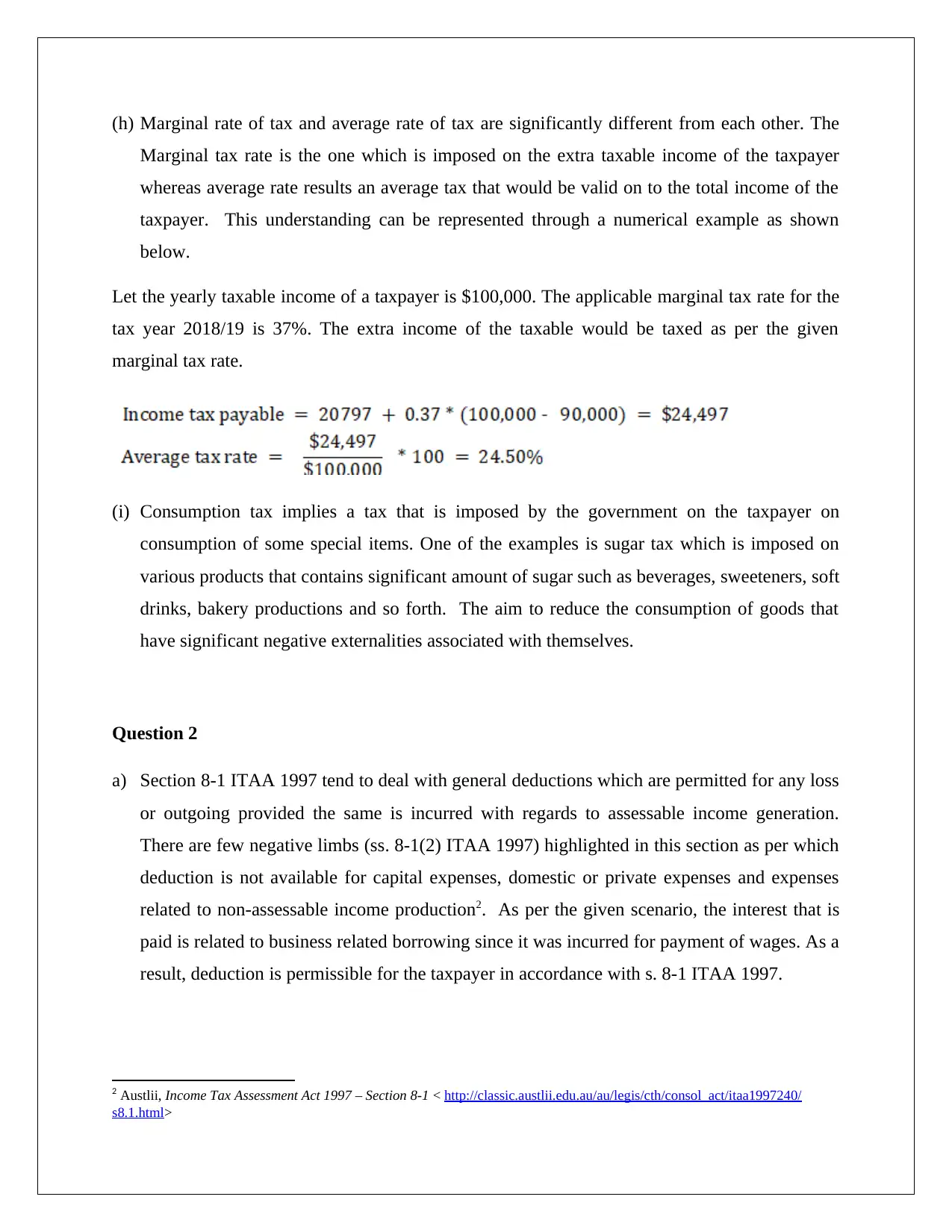
(h) Marginal rate of tax and average rate of tax are significantly different from each other. The
Marginal tax rate is the one which is imposed on the extra taxable income of the taxpayer
whereas average rate results an average tax that would be valid on to the total income of the
taxpayer. This understanding can be represented through a numerical example as shown
below.
Let the yearly taxable income of a taxpayer is $100,000. The applicable marginal tax rate for the
tax year 2018/19 is 37%. The extra income of the taxable would be taxed as per the given
marginal tax rate.
(i) Consumption tax implies a tax that is imposed by the government on the taxpayer on
consumption of some special items. One of the examples is sugar tax which is imposed on
various products that contains significant amount of sugar such as beverages, sweeteners, soft
drinks, bakery productions and so forth. The aim to reduce the consumption of goods that
have significant negative externalities associated with themselves.
Question 2
a) Section 8-1 ITAA 1997 tend to deal with general deductions which are permitted for any loss
or outgoing provided the same is incurred with regards to assessable income generation.
There are few negative limbs (ss. 8-1(2) ITAA 1997) highlighted in this section as per which
deduction is not available for capital expenses, domestic or private expenses and expenses
related to non-assessable income production2. As per the given scenario, the interest that is
paid is related to business related borrowing since it was incurred for payment of wages. As a
result, deduction is permissible for the taxpayer in accordance with s. 8-1 ITAA 1997.
2 Austlii, Income Tax Assessment Act 1997 – Section 8-1 < http://classic.austlii.edu.au/au/legis/cth/consol_act/itaa1997240/
s8.1.html>
Marginal tax rate is the one which is imposed on the extra taxable income of the taxpayer
whereas average rate results an average tax that would be valid on to the total income of the
taxpayer. This understanding can be represented through a numerical example as shown
below.
Let the yearly taxable income of a taxpayer is $100,000. The applicable marginal tax rate for the
tax year 2018/19 is 37%. The extra income of the taxable would be taxed as per the given
marginal tax rate.
(i) Consumption tax implies a tax that is imposed by the government on the taxpayer on
consumption of some special items. One of the examples is sugar tax which is imposed on
various products that contains significant amount of sugar such as beverages, sweeteners, soft
drinks, bakery productions and so forth. The aim to reduce the consumption of goods that
have significant negative externalities associated with themselves.
Question 2
a) Section 8-1 ITAA 1997 tend to deal with general deductions which are permitted for any loss
or outgoing provided the same is incurred with regards to assessable income generation.
There are few negative limbs (ss. 8-1(2) ITAA 1997) highlighted in this section as per which
deduction is not available for capital expenses, domestic or private expenses and expenses
related to non-assessable income production2. As per the given scenario, the interest that is
paid is related to business related borrowing since it was incurred for payment of wages. As a
result, deduction is permissible for the taxpayer in accordance with s. 8-1 ITAA 1997.
2 Austlii, Income Tax Assessment Act 1997 – Section 8-1 < http://classic.austlii.edu.au/au/legis/cth/consol_act/itaa1997240/
s8.1.html>
⊘ This is a preview!⊘
Do you want full access?
Subscribe today to unlock all pages.

Trusted by 1+ million students worldwide
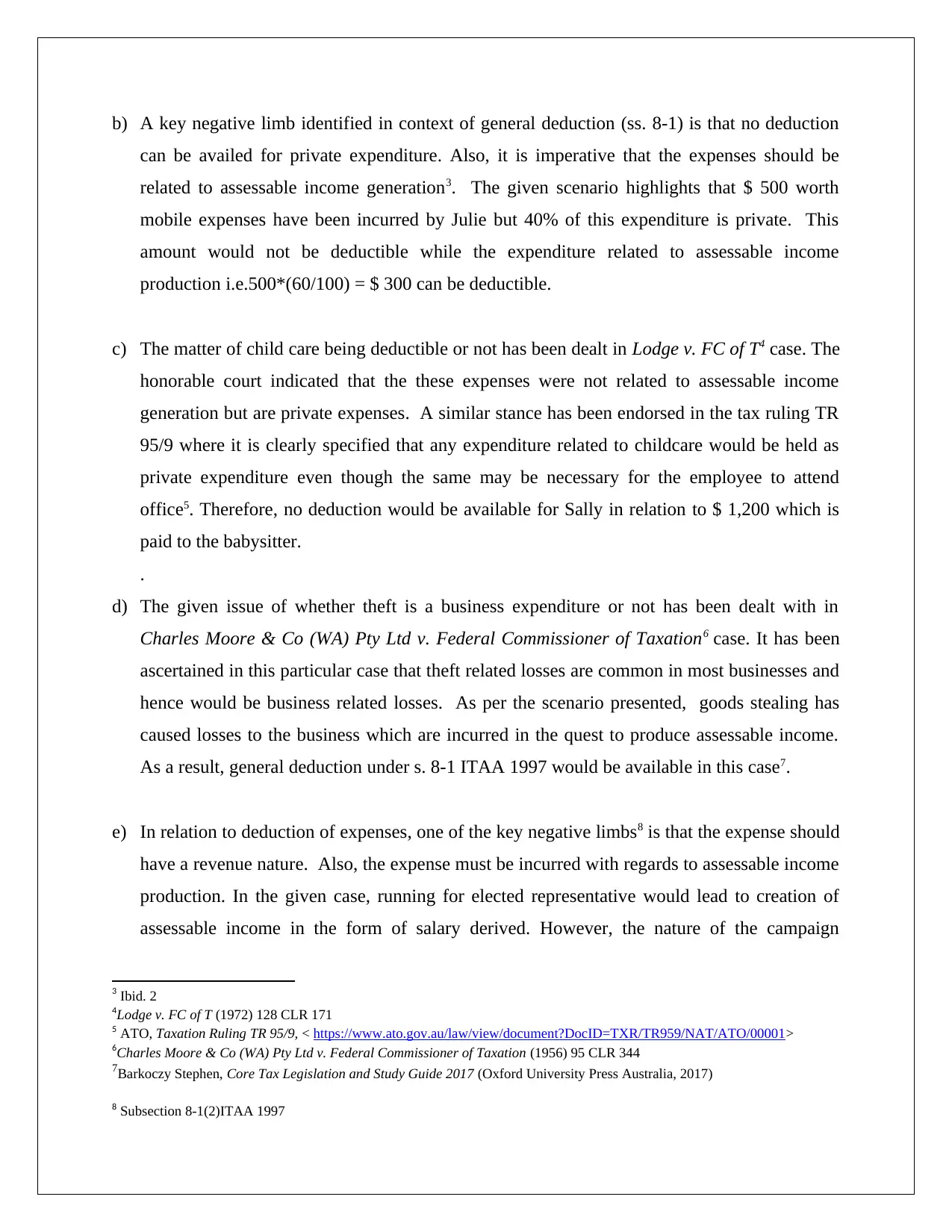
b) A key negative limb identified in context of general deduction (ss. 8-1) is that no deduction
can be availed for private expenditure. Also, it is imperative that the expenses should be
related to assessable income generation3. The given scenario highlights that $ 500 worth
mobile expenses have been incurred by Julie but 40% of this expenditure is private. This
amount would not be deductible while the expenditure related to assessable income
production i.e.500*(60/100) = $ 300 can be deductible.
c) The matter of child care being deductible or not has been dealt in Lodge v. FC of T4 case. The
honorable court indicated that the these expenses were not related to assessable income
generation but are private expenses. A similar stance has been endorsed in the tax ruling TR
95/9 where it is clearly specified that any expenditure related to childcare would be held as
private expenditure even though the same may be necessary for the employee to attend
office5. Therefore, no deduction would be available for Sally in relation to $ 1,200 which is
paid to the babysitter.
.
d) The given issue of whether theft is a business expenditure or not has been dealt with in
Charles Moore & Co (WA) Pty Ltd v. Federal Commissioner of Taxation6 case. It has been
ascertained in this particular case that theft related losses are common in most businesses and
hence would be business related losses. As per the scenario presented, goods stealing has
caused losses to the business which are incurred in the quest to produce assessable income.
As a result, general deduction under s. 8-1 ITAA 1997 would be available in this case7.
e) In relation to deduction of expenses, one of the key negative limbs8 is that the expense should
have a revenue nature. Also, the expense must be incurred with regards to assessable income
production. In the given case, running for elected representative would lead to creation of
assessable income in the form of salary derived. However, the nature of the campaign
3 Ibid. 2
4Lodge v. FC of T (1972) 128 CLR 171
5 ATO, Taxation Ruling TR 95/9, < https://www.ato.gov.au/law/view/document?DocID=TXR/TR959/NAT/ATO/00001>
6Charles Moore & Co (WA) Pty Ltd v. Federal Commissioner of Taxation (1956) 95 CLR 344
7Barkoczy Stephen, Core Tax Legislation and Study Guide 2017 (Oxford University Press Australia, 2017)
8 Subsection 8-1(2)ITAA 1997
can be availed for private expenditure. Also, it is imperative that the expenses should be
related to assessable income generation3. The given scenario highlights that $ 500 worth
mobile expenses have been incurred by Julie but 40% of this expenditure is private. This
amount would not be deductible while the expenditure related to assessable income
production i.e.500*(60/100) = $ 300 can be deductible.
c) The matter of child care being deductible or not has been dealt in Lodge v. FC of T4 case. The
honorable court indicated that the these expenses were not related to assessable income
generation but are private expenses. A similar stance has been endorsed in the tax ruling TR
95/9 where it is clearly specified that any expenditure related to childcare would be held as
private expenditure even though the same may be necessary for the employee to attend
office5. Therefore, no deduction would be available for Sally in relation to $ 1,200 which is
paid to the babysitter.
.
d) The given issue of whether theft is a business expenditure or not has been dealt with in
Charles Moore & Co (WA) Pty Ltd v. Federal Commissioner of Taxation6 case. It has been
ascertained in this particular case that theft related losses are common in most businesses and
hence would be business related losses. As per the scenario presented, goods stealing has
caused losses to the business which are incurred in the quest to produce assessable income.
As a result, general deduction under s. 8-1 ITAA 1997 would be available in this case7.
e) In relation to deduction of expenses, one of the key negative limbs8 is that the expense should
have a revenue nature. Also, the expense must be incurred with regards to assessable income
production. In the given case, running for elected representative would lead to creation of
assessable income in the form of salary derived. However, the nature of the campaign
3 Ibid. 2
4Lodge v. FC of T (1972) 128 CLR 171
5 ATO, Taxation Ruling TR 95/9, < https://www.ato.gov.au/law/view/document?DocID=TXR/TR959/NAT/ATO/00001>
6Charles Moore & Co (WA) Pty Ltd v. Federal Commissioner of Taxation (1956) 95 CLR 344
7Barkoczy Stephen, Core Tax Legislation and Study Guide 2017 (Oxford University Press Australia, 2017)
8 Subsection 8-1(2)ITAA 1997
Paraphrase This Document
Need a fresh take? Get an instant paraphrase of this document with our AI Paraphraser
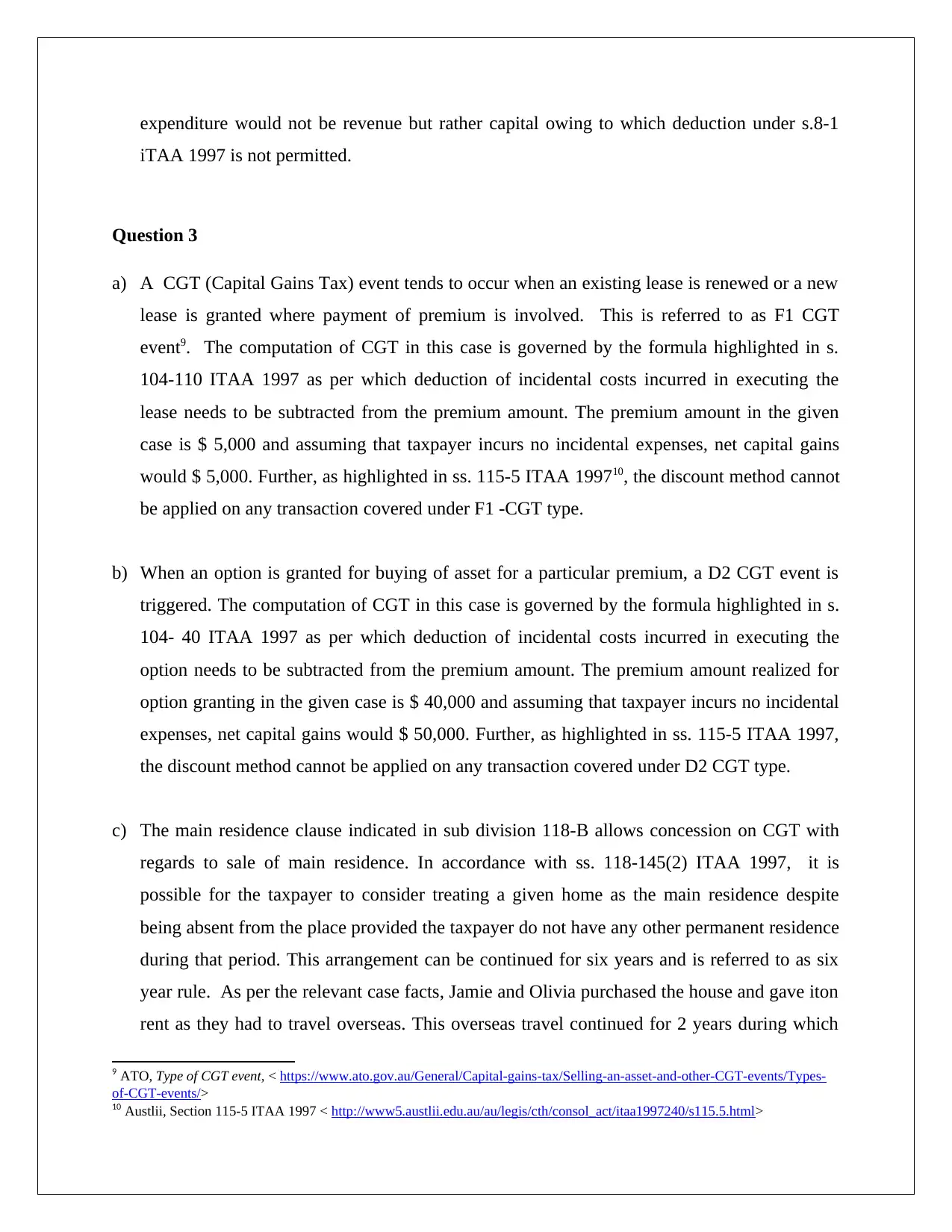
expenditure would not be revenue but rather capital owing to which deduction under s.8-1
iTAA 1997 is not permitted.
Question 3
a) A CGT (Capital Gains Tax) event tends to occur when an existing lease is renewed or a new
lease is granted where payment of premium is involved. This is referred to as F1 CGT
event9. The computation of CGT in this case is governed by the formula highlighted in s.
104-110 ITAA 1997 as per which deduction of incidental costs incurred in executing the
lease needs to be subtracted from the premium amount. The premium amount in the given
case is $ 5,000 and assuming that taxpayer incurs no incidental expenses, net capital gains
would $ 5,000. Further, as highlighted in ss. 115-5 ITAA 199710, the discount method cannot
be applied on any transaction covered under F1 -CGT type.
b) When an option is granted for buying of asset for a particular premium, a D2 CGT event is
triggered. The computation of CGT in this case is governed by the formula highlighted in s.
104- 40 ITAA 1997 as per which deduction of incidental costs incurred in executing the
option needs to be subtracted from the premium amount. The premium amount realized for
option granting in the given case is $ 40,000 and assuming that taxpayer incurs no incidental
expenses, net capital gains would $ 50,000. Further, as highlighted in ss. 115-5 ITAA 1997,
the discount method cannot be applied on any transaction covered under D2 CGT type.
c) The main residence clause indicated in sub division 118-B allows concession on CGT with
regards to sale of main residence. In accordance with ss. 118-145(2) ITAA 1997, it is
possible for the taxpayer to consider treating a given home as the main residence despite
being absent from the place provided the taxpayer do not have any other permanent residence
during that period. This arrangement can be continued for six years and is referred to as six
year rule. As per the relevant case facts, Jamie and Olivia purchased the house and gave iton
rent as they had to travel overseas. This overseas travel continued for 2 years during which
9 ATO, Type of CGT event, < https://www.ato.gov.au/General/Capital-gains-tax/Selling-an-asset-and-other-CGT-events/Types-
of-CGT-events/>
10 Austlii, Section 115-5 ITAA 1997 < http://www5.austlii.edu.au/au/legis/cth/consol_act/itaa1997240/s115.5.html>
iTAA 1997 is not permitted.
Question 3
a) A CGT (Capital Gains Tax) event tends to occur when an existing lease is renewed or a new
lease is granted where payment of premium is involved. This is referred to as F1 CGT
event9. The computation of CGT in this case is governed by the formula highlighted in s.
104-110 ITAA 1997 as per which deduction of incidental costs incurred in executing the
lease needs to be subtracted from the premium amount. The premium amount in the given
case is $ 5,000 and assuming that taxpayer incurs no incidental expenses, net capital gains
would $ 5,000. Further, as highlighted in ss. 115-5 ITAA 199710, the discount method cannot
be applied on any transaction covered under F1 -CGT type.
b) When an option is granted for buying of asset for a particular premium, a D2 CGT event is
triggered. The computation of CGT in this case is governed by the formula highlighted in s.
104- 40 ITAA 1997 as per which deduction of incidental costs incurred in executing the
option needs to be subtracted from the premium amount. The premium amount realized for
option granting in the given case is $ 40,000 and assuming that taxpayer incurs no incidental
expenses, net capital gains would $ 50,000. Further, as highlighted in ss. 115-5 ITAA 1997,
the discount method cannot be applied on any transaction covered under D2 CGT type.
c) The main residence clause indicated in sub division 118-B allows concession on CGT with
regards to sale of main residence. In accordance with ss. 118-145(2) ITAA 1997, it is
possible for the taxpayer to consider treating a given home as the main residence despite
being absent from the place provided the taxpayer do not have any other permanent residence
during that period. This arrangement can be continued for six years and is referred to as six
year rule. As per the relevant case facts, Jamie and Olivia purchased the house and gave iton
rent as they had to travel overseas. This overseas travel continued for 2 years during which
9 ATO, Type of CGT event, < https://www.ato.gov.au/General/Capital-gains-tax/Selling-an-asset-and-other-CGT-events/Types-
of-CGT-events/>
10 Austlii, Section 115-5 ITAA 1997 < http://www5.austlii.edu.au/au/legis/cth/consol_act/itaa1997240/s115.5.html>
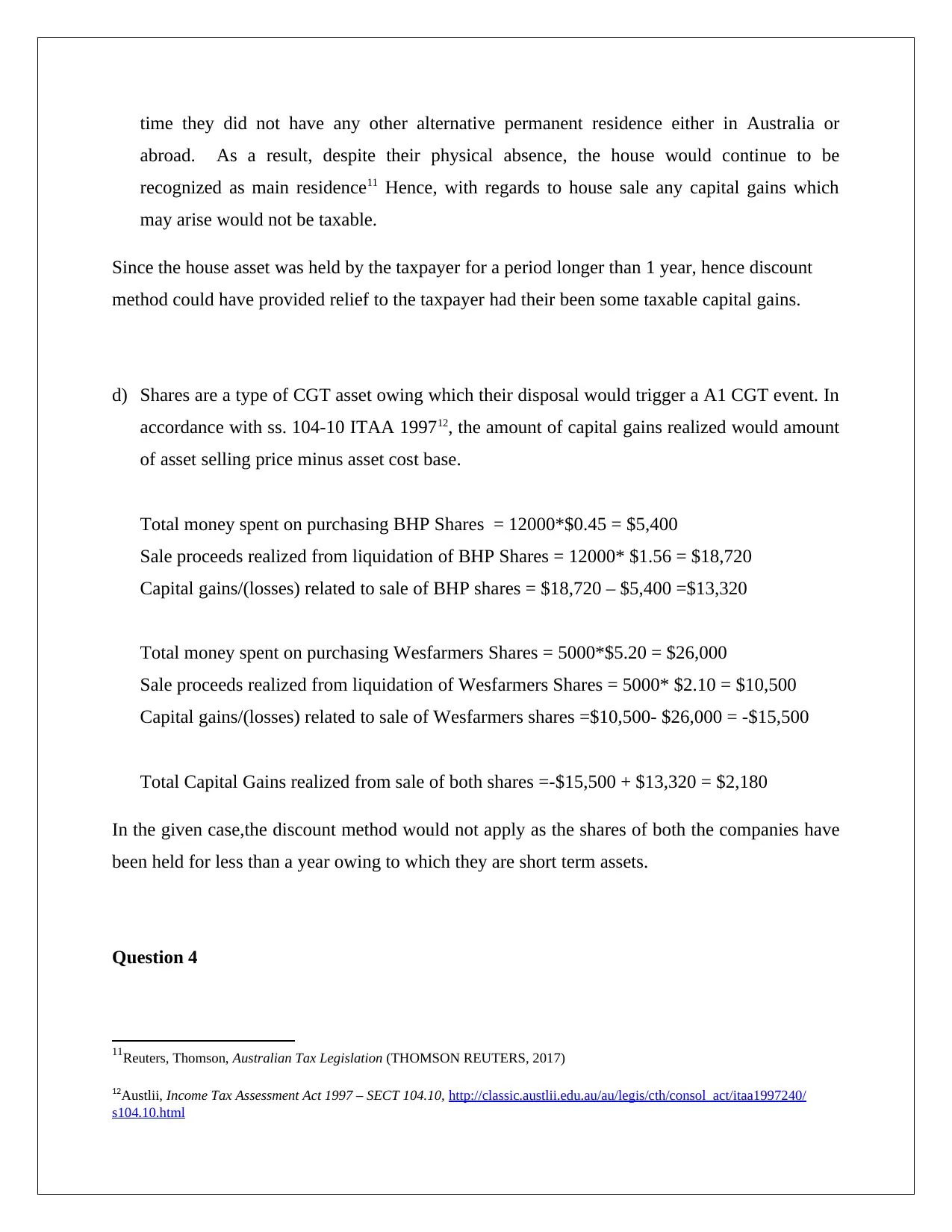
time they did not have any other alternative permanent residence either in Australia or
abroad. As a result, despite their physical absence, the house would continue to be
recognized as main residence11 Hence, with regards to house sale any capital gains which
may arise would not be taxable.
Since the house asset was held by the taxpayer for a period longer than 1 year, hence discount
method could have provided relief to the taxpayer had their been some taxable capital gains.
d) Shares are a type of CGT asset owing which their disposal would trigger a A1 CGT event. In
accordance with ss. 104-10 ITAA 199712, the amount of capital gains realized would amount
of asset selling price minus asset cost base.
Total money spent on purchasing BHP Shares = 12000*$0.45 = $5,400
Sale proceeds realized from liquidation of BHP Shares = 12000* $1.56 = $18,720
Capital gains/(losses) related to sale of BHP shares = $18,720 – $5,400 =$13,320
Total money spent on purchasing Wesfarmers Shares = 5000*$5.20 = $26,000
Sale proceeds realized from liquidation of Wesfarmers Shares = 5000* $2.10 = $10,500
Capital gains/(losses) related to sale of Wesfarmers shares =$10,500- $26,000 = -$15,500
Total Capital Gains realized from sale of both shares =-$15,500 + $13,320 = $2,180
In the given case,the discount method would not apply as the shares of both the companies have
been held for less than a year owing to which they are short term assets.
Question 4
11Reuters, Thomson, Australian Tax Legislation (THOMSON REUTERS, 2017)
12Austlii, Income Tax Assessment Act 1997 – SECT 104.10, http://classic.austlii.edu.au/au/legis/cth/consol_act/itaa1997240/
s104.10.html
abroad. As a result, despite their physical absence, the house would continue to be
recognized as main residence11 Hence, with regards to house sale any capital gains which
may arise would not be taxable.
Since the house asset was held by the taxpayer for a period longer than 1 year, hence discount
method could have provided relief to the taxpayer had their been some taxable capital gains.
d) Shares are a type of CGT asset owing which their disposal would trigger a A1 CGT event. In
accordance with ss. 104-10 ITAA 199712, the amount of capital gains realized would amount
of asset selling price minus asset cost base.
Total money spent on purchasing BHP Shares = 12000*$0.45 = $5,400
Sale proceeds realized from liquidation of BHP Shares = 12000* $1.56 = $18,720
Capital gains/(losses) related to sale of BHP shares = $18,720 – $5,400 =$13,320
Total money spent on purchasing Wesfarmers Shares = 5000*$5.20 = $26,000
Sale proceeds realized from liquidation of Wesfarmers Shares = 5000* $2.10 = $10,500
Capital gains/(losses) related to sale of Wesfarmers shares =$10,500- $26,000 = -$15,500
Total Capital Gains realized from sale of both shares =-$15,500 + $13,320 = $2,180
In the given case,the discount method would not apply as the shares of both the companies have
been held for less than a year owing to which they are short term assets.
Question 4
11Reuters, Thomson, Australian Tax Legislation (THOMSON REUTERS, 2017)
12Austlii, Income Tax Assessment Act 1997 – SECT 104.10, http://classic.austlii.edu.au/au/legis/cth/consol_act/itaa1997240/
s104.10.html
⊘ This is a preview!⊘
Do you want full access?
Subscribe today to unlock all pages.

Trusted by 1+ million students worldwide
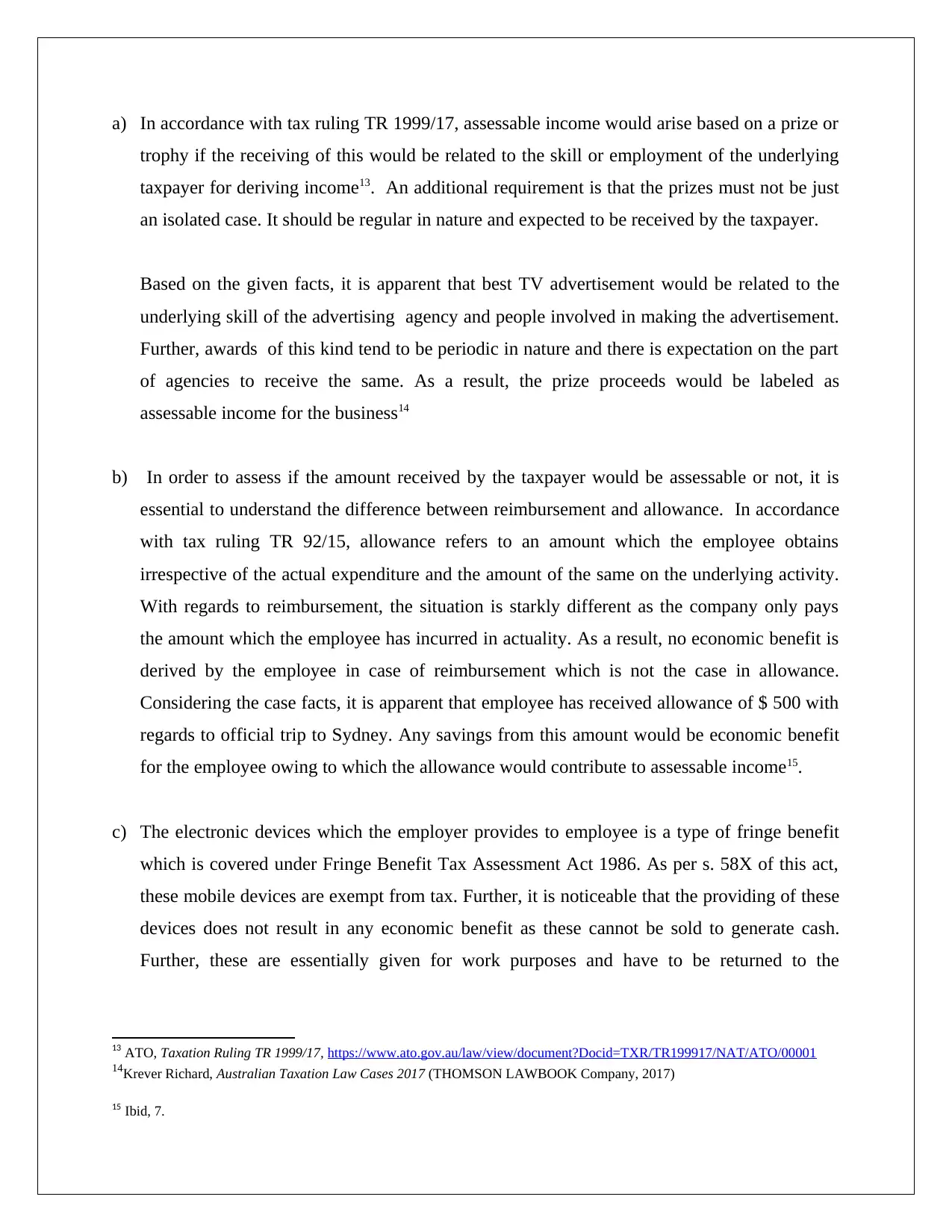
a) In accordance with tax ruling TR 1999/17, assessable income would arise based on a prize or
trophy if the receiving of this would be related to the skill or employment of the underlying
taxpayer for deriving income13. An additional requirement is that the prizes must not be just
an isolated case. It should be regular in nature and expected to be received by the taxpayer.
Based on the given facts, it is apparent that best TV advertisement would be related to the
underlying skill of the advertising agency and people involved in making the advertisement.
Further, awards of this kind tend to be periodic in nature and there is expectation on the part
of agencies to receive the same. As a result, the prize proceeds would be labeled as
assessable income for the business14
b) In order to assess if the amount received by the taxpayer would be assessable or not, it is
essential to understand the difference between reimbursement and allowance. In accordance
with tax ruling TR 92/15, allowance refers to an amount which the employee obtains
irrespective of the actual expenditure and the amount of the same on the underlying activity.
With regards to reimbursement, the situation is starkly different as the company only pays
the amount which the employee has incurred in actuality. As a result, no economic benefit is
derived by the employee in case of reimbursement which is not the case in allowance.
Considering the case facts, it is apparent that employee has received allowance of $ 500 with
regards to official trip to Sydney. Any savings from this amount would be economic benefit
for the employee owing to which the allowance would contribute to assessable income15.
c) The electronic devices which the employer provides to employee is a type of fringe benefit
which is covered under Fringe Benefit Tax Assessment Act 1986. As per s. 58X of this act,
these mobile devices are exempt from tax. Further, it is noticeable that the providing of these
devices does not result in any economic benefit as these cannot be sold to generate cash.
Further, these are essentially given for work purposes and have to be returned to the
13 ATO, Taxation Ruling TR 1999/17, https://www.ato.gov.au/law/view/document?Docid=TXR/TR199917/NAT/ATO/00001
14Krever Richard, Australian Taxation Law Cases 2017 (THOMSON LAWBOOK Company, 2017)
15 Ibid, 7.
trophy if the receiving of this would be related to the skill or employment of the underlying
taxpayer for deriving income13. An additional requirement is that the prizes must not be just
an isolated case. It should be regular in nature and expected to be received by the taxpayer.
Based on the given facts, it is apparent that best TV advertisement would be related to the
underlying skill of the advertising agency and people involved in making the advertisement.
Further, awards of this kind tend to be periodic in nature and there is expectation on the part
of agencies to receive the same. As a result, the prize proceeds would be labeled as
assessable income for the business14
b) In order to assess if the amount received by the taxpayer would be assessable or not, it is
essential to understand the difference between reimbursement and allowance. In accordance
with tax ruling TR 92/15, allowance refers to an amount which the employee obtains
irrespective of the actual expenditure and the amount of the same on the underlying activity.
With regards to reimbursement, the situation is starkly different as the company only pays
the amount which the employee has incurred in actuality. As a result, no economic benefit is
derived by the employee in case of reimbursement which is not the case in allowance.
Considering the case facts, it is apparent that employee has received allowance of $ 500 with
regards to official trip to Sydney. Any savings from this amount would be economic benefit
for the employee owing to which the allowance would contribute to assessable income15.
c) The electronic devices which the employer provides to employee is a type of fringe benefit
which is covered under Fringe Benefit Tax Assessment Act 1986. As per s. 58X of this act,
these mobile devices are exempt from tax. Further, it is noticeable that the providing of these
devices does not result in any economic benefit as these cannot be sold to generate cash.
Further, these are essentially given for work purposes and have to be returned to the
13 ATO, Taxation Ruling TR 1999/17, https://www.ato.gov.au/law/view/document?Docid=TXR/TR199917/NAT/ATO/00001
14Krever Richard, Australian Taxation Law Cases 2017 (THOMSON LAWBOOK Company, 2017)
15 Ibid, 7.
Paraphrase This Document
Need a fresh take? Get an instant paraphrase of this document with our AI Paraphraser
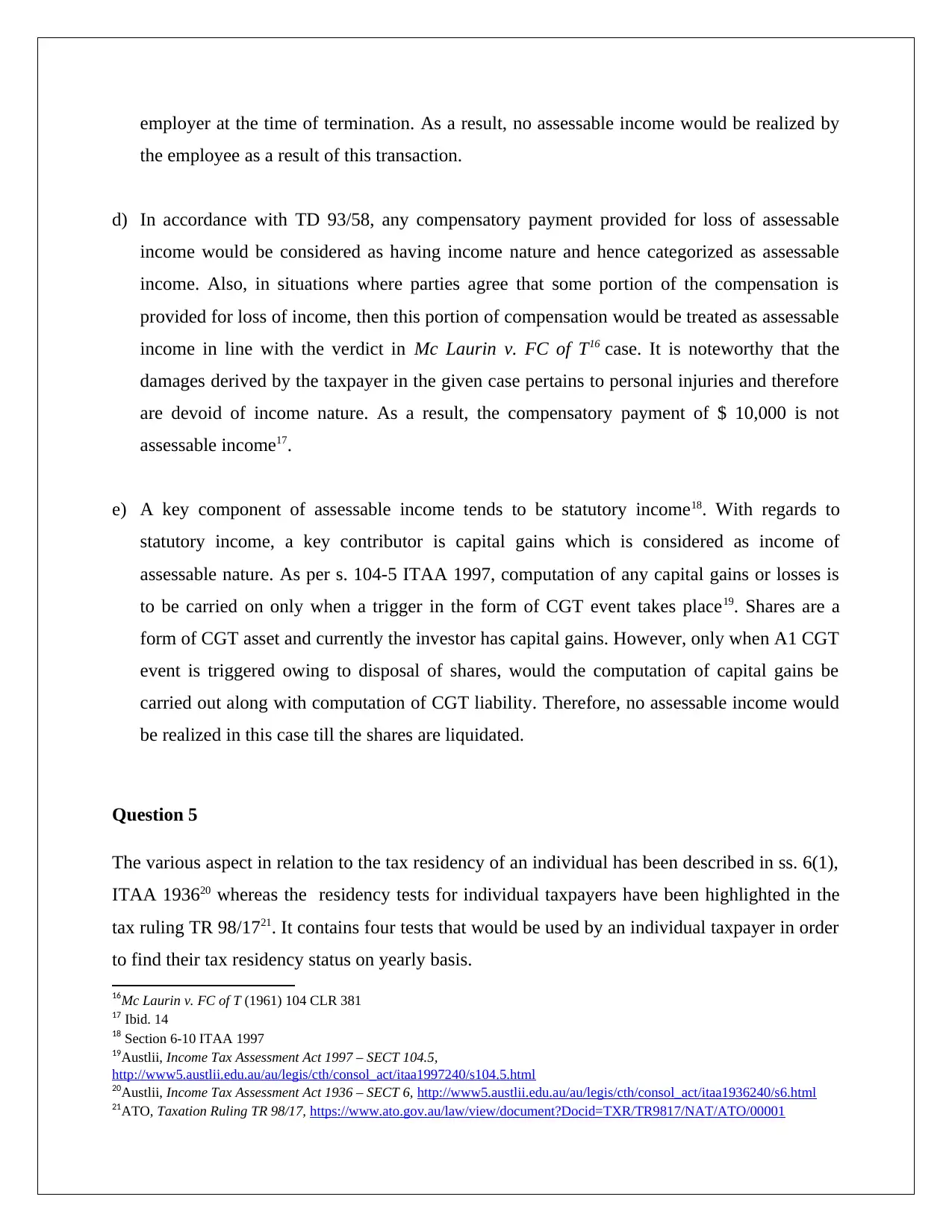
employer at the time of termination. As a result, no assessable income would be realized by
the employee as a result of this transaction.
d) In accordance with TD 93/58, any compensatory payment provided for loss of assessable
income would be considered as having income nature and hence categorized as assessable
income. Also, in situations where parties agree that some portion of the compensation is
provided for loss of income, then this portion of compensation would be treated as assessable
income in line with the verdict in Mc Laurin v. FC of T16 case. It is noteworthy that the
damages derived by the taxpayer in the given case pertains to personal injuries and therefore
are devoid of income nature. As a result, the compensatory payment of $ 10,000 is not
assessable income17.
e) A key component of assessable income tends to be statutory income18. With regards to
statutory income, a key contributor is capital gains which is considered as income of
assessable nature. As per s. 104-5 ITAA 1997, computation of any capital gains or losses is
to be carried on only when a trigger in the form of CGT event takes place19. Shares are a
form of CGT asset and currently the investor has capital gains. However, only when A1 CGT
event is triggered owing to disposal of shares, would the computation of capital gains be
carried out along with computation of CGT liability. Therefore, no assessable income would
be realized in this case till the shares are liquidated.
Question 5
The various aspect in relation to the tax residency of an individual has been described in ss. 6(1),
ITAA 193620 whereas the residency tests for individual taxpayers have been highlighted in the
tax ruling TR 98/1721. It contains four tests that would be used by an individual taxpayer in order
to find their tax residency status on yearly basis.
16Mc Laurin v. FC of T (1961) 104 CLR 381
17 Ibid. 14
18 Section 6-10 ITAA 1997
19Austlii, Income Tax Assessment Act 1997 – SECT 104.5,
http://www5.austlii.edu.au/au/legis/cth/consol_act/itaa1997240/s104.5.html
20Austlii, Income Tax Assessment Act 1936 – SECT 6, http://www5.austlii.edu.au/au/legis/cth/consol_act/itaa1936240/s6.html
21ATO, Taxation Ruling TR 98/17, https://www.ato.gov.au/law/view/document?Docid=TXR/TR9817/NAT/ATO/00001
the employee as a result of this transaction.
d) In accordance with TD 93/58, any compensatory payment provided for loss of assessable
income would be considered as having income nature and hence categorized as assessable
income. Also, in situations where parties agree that some portion of the compensation is
provided for loss of income, then this portion of compensation would be treated as assessable
income in line with the verdict in Mc Laurin v. FC of T16 case. It is noteworthy that the
damages derived by the taxpayer in the given case pertains to personal injuries and therefore
are devoid of income nature. As a result, the compensatory payment of $ 10,000 is not
assessable income17.
e) A key component of assessable income tends to be statutory income18. With regards to
statutory income, a key contributor is capital gains which is considered as income of
assessable nature. As per s. 104-5 ITAA 1997, computation of any capital gains or losses is
to be carried on only when a trigger in the form of CGT event takes place19. Shares are a
form of CGT asset and currently the investor has capital gains. However, only when A1 CGT
event is triggered owing to disposal of shares, would the computation of capital gains be
carried out along with computation of CGT liability. Therefore, no assessable income would
be realized in this case till the shares are liquidated.
Question 5
The various aspect in relation to the tax residency of an individual has been described in ss. 6(1),
ITAA 193620 whereas the residency tests for individual taxpayers have been highlighted in the
tax ruling TR 98/1721. It contains four tests that would be used by an individual taxpayer in order
to find their tax residency status on yearly basis.
16Mc Laurin v. FC of T (1961) 104 CLR 381
17 Ibid. 14
18 Section 6-10 ITAA 1997
19Austlii, Income Tax Assessment Act 1997 – SECT 104.5,
http://www5.austlii.edu.au/au/legis/cth/consol_act/itaa1997240/s104.5.html
20Austlii, Income Tax Assessment Act 1936 – SECT 6, http://www5.austlii.edu.au/au/legis/cth/consol_act/itaa1936240/s6.html
21ATO, Taxation Ruling TR 98/17, https://www.ato.gov.au/law/view/document?Docid=TXR/TR9817/NAT/ATO/00001
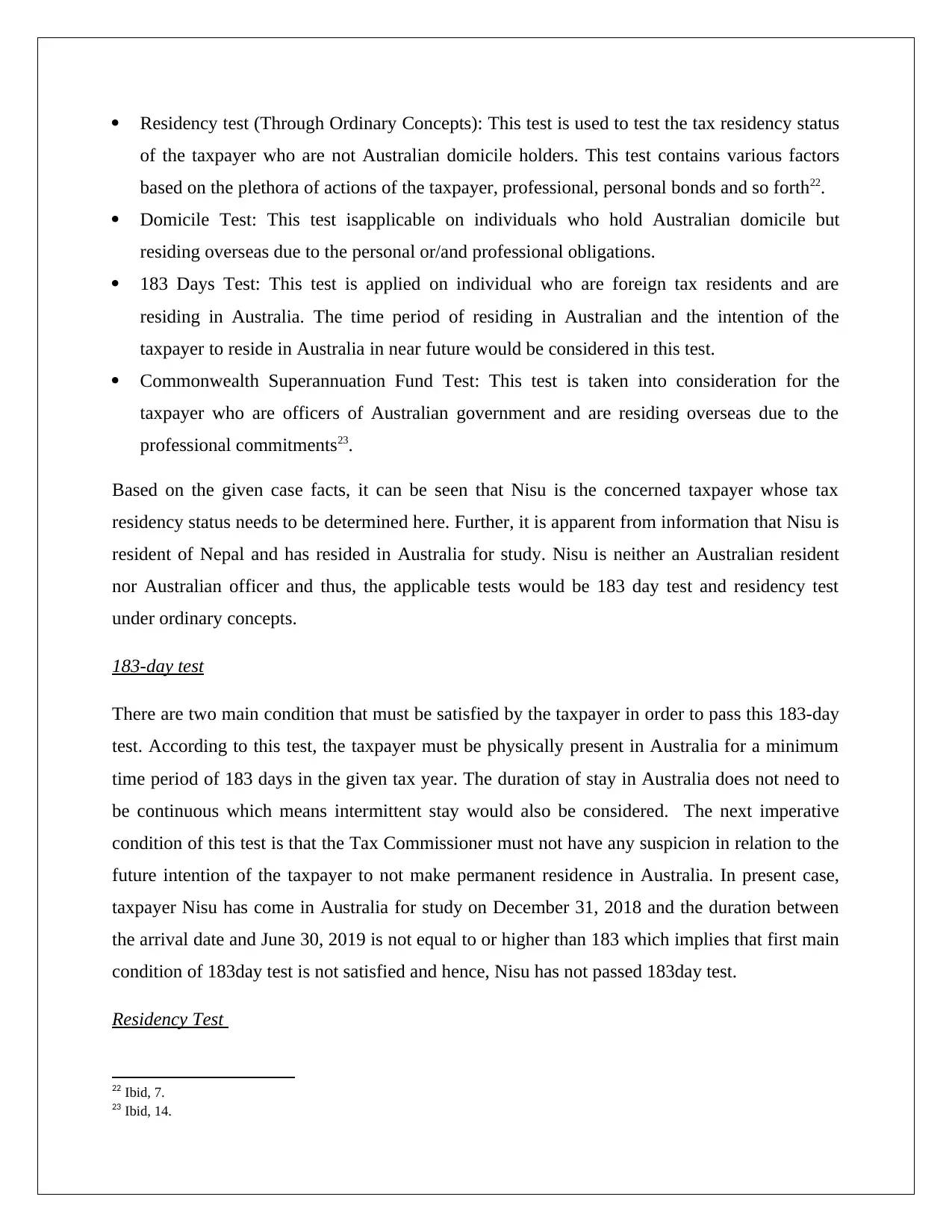
Residency test (Through Ordinary Concepts): This test is used to test the tax residency status
of the taxpayer who are not Australian domicile holders. This test contains various factors
based on the plethora of actions of the taxpayer, professional, personal bonds and so forth22.
Domicile Test: This test isapplicable on individuals who hold Australian domicile but
residing overseas due to the personal or/and professional obligations.
183 Days Test: This test is applied on individual who are foreign tax residents and are
residing in Australia. The time period of residing in Australian and the intention of the
taxpayer to reside in Australia in near future would be considered in this test.
Commonwealth Superannuation Fund Test: This test is taken into consideration for the
taxpayer who are officers of Australian government and are residing overseas due to the
professional commitments23.
Based on the given case facts, it can be seen that Nisu is the concerned taxpayer whose tax
residency status needs to be determined here. Further, it is apparent from information that Nisu is
resident of Nepal and has resided in Australia for study. Nisu is neither an Australian resident
nor Australian officer and thus, the applicable tests would be 183 day test and residency test
under ordinary concepts.
183-day test
There are two main condition that must be satisfied by the taxpayer in order to pass this 183-day
test. According to this test, the taxpayer must be physically present in Australia for a minimum
time period of 183 days in the given tax year. The duration of stay in Australia does not need to
be continuous which means intermittent stay would also be considered. The next imperative
condition of this test is that the Tax Commissioner must not have any suspicion in relation to the
future intention of the taxpayer to not make permanent residence in Australia. In present case,
taxpayer Nisu has come in Australia for study on December 31, 2018 and the duration between
the arrival date and June 30, 2019 is not equal to or higher than 183 which implies that first main
condition of 183day test is not satisfied and hence, Nisu has not passed 183day test.
Residency Test
22 Ibid, 7.
23 Ibid, 14.
of the taxpayer who are not Australian domicile holders. This test contains various factors
based on the plethora of actions of the taxpayer, professional, personal bonds and so forth22.
Domicile Test: This test isapplicable on individuals who hold Australian domicile but
residing overseas due to the personal or/and professional obligations.
183 Days Test: This test is applied on individual who are foreign tax residents and are
residing in Australia. The time period of residing in Australian and the intention of the
taxpayer to reside in Australia in near future would be considered in this test.
Commonwealth Superannuation Fund Test: This test is taken into consideration for the
taxpayer who are officers of Australian government and are residing overseas due to the
professional commitments23.
Based on the given case facts, it can be seen that Nisu is the concerned taxpayer whose tax
residency status needs to be determined here. Further, it is apparent from information that Nisu is
resident of Nepal and has resided in Australia for study. Nisu is neither an Australian resident
nor Australian officer and thus, the applicable tests would be 183 day test and residency test
under ordinary concepts.
183-day test
There are two main condition that must be satisfied by the taxpayer in order to pass this 183-day
test. According to this test, the taxpayer must be physically present in Australia for a minimum
time period of 183 days in the given tax year. The duration of stay in Australia does not need to
be continuous which means intermittent stay would also be considered. The next imperative
condition of this test is that the Tax Commissioner must not have any suspicion in relation to the
future intention of the taxpayer to not make permanent residence in Australia. In present case,
taxpayer Nisu has come in Australia for study on December 31, 2018 and the duration between
the arrival date and June 30, 2019 is not equal to or higher than 183 which implies that first main
condition of 183day test is not satisfied and hence, Nisu has not passed 183day test.
Residency Test
22 Ibid, 7.
23 Ibid, 14.
⊘ This is a preview!⊘
Do you want full access?
Subscribe today to unlock all pages.

Trusted by 1+ million students worldwide

According to TR 98/17, there is no direct meaning of word resides in the Australian statute.
Thereby, the keen factors in relation to the taxpayer would be examined under ordinary concepts
which has been drawn from various relevant legal case laws and judgements.
Intention of taxpayer and purpose of visit: As per the judgement of FC of T v. Pechey24 case,
the purpose behind the visit is an imperative aspect as the taxpayer resided in Australia for
study and for long term (more than six month) are categorised as significant reasons leading
to tax residency of Australia.
Personal and professional bonds: The taxpayer would be termed as tax resident of Australia
when he/she has strong personal or professional relationship in Australia in comparison of
their country of origin as evident from the judgement of the Peel v. The Commissioners of
Inland Revenue25 case.
Presence and location of the taxpayer’s assets: When the taxpayer has intention to make
Australia as permanent residence in future and in the same regards has purchased
fixed/movable assets in Australian, then this aspect would also be considered by tax
commissioner to decide the tax residency status of taxpayer.
Social involvement of taxpayer:When the social involvement of taxpayer is similar like that
in country of origin then this would also be contributed in the aspect of being tax resident of
Australia as per TR 98/1726.
In present case, Nisu has come to Australia for a significant reason i.e. study and also, the
duration of the course completion is of three years. Further, he has social involvement in
Australia which is similar to what he used to do in her country of origin (Nepal). These factors
indicatethat Nisu has pass the main pre-requisite of residency test and therefore, it can be said
that Nisu would be considered as tax resident of Australia for the income tax year 2018/19.
Bibliography
ATO, Income Tax Assessment Act 1997 – SECT 118.5,
http://classic.austlii.edu.au/au/legis/cth/consol_act/itaa1997240/s118.5.html
24FC of T v. Pechey75 ATC 4083
25Peel v. The Commissioners of Inland Revenue (1927) 13 TC 443
26
Thereby, the keen factors in relation to the taxpayer would be examined under ordinary concepts
which has been drawn from various relevant legal case laws and judgements.
Intention of taxpayer and purpose of visit: As per the judgement of FC of T v. Pechey24 case,
the purpose behind the visit is an imperative aspect as the taxpayer resided in Australia for
study and for long term (more than six month) are categorised as significant reasons leading
to tax residency of Australia.
Personal and professional bonds: The taxpayer would be termed as tax resident of Australia
when he/she has strong personal or professional relationship in Australia in comparison of
their country of origin as evident from the judgement of the Peel v. The Commissioners of
Inland Revenue25 case.
Presence and location of the taxpayer’s assets: When the taxpayer has intention to make
Australia as permanent residence in future and in the same regards has purchased
fixed/movable assets in Australian, then this aspect would also be considered by tax
commissioner to decide the tax residency status of taxpayer.
Social involvement of taxpayer:When the social involvement of taxpayer is similar like that
in country of origin then this would also be contributed in the aspect of being tax resident of
Australia as per TR 98/1726.
In present case, Nisu has come to Australia for a significant reason i.e. study and also, the
duration of the course completion is of three years. Further, he has social involvement in
Australia which is similar to what he used to do in her country of origin (Nepal). These factors
indicatethat Nisu has pass the main pre-requisite of residency test and therefore, it can be said
that Nisu would be considered as tax resident of Australia for the income tax year 2018/19.
Bibliography
ATO, Income Tax Assessment Act 1997 – SECT 118.5,
http://classic.austlii.edu.au/au/legis/cth/consol_act/itaa1997240/s118.5.html
24FC of T v. Pechey75 ATC 4083
25Peel v. The Commissioners of Inland Revenue (1927) 13 TC 443
26
Paraphrase This Document
Need a fresh take? Get an instant paraphrase of this document with our AI Paraphraser

ATO, Taxable Ruling TR 2018/4, https://www.ato.gov.au/law/view/document?DocID=TXR
%2FTR20184%2FNAT%2FATO%2F00001
ATO, Taxation Ruling TR 1999/17,
https://www.ato.gov.au/law/view/document?Docid=TXR/TR199917/NAT/ATO/00001
ATO, Taxation Ruling TR 98/17,
https://www.ato.gov.au/law/view/document?Docid=TXR/TR9817/NAT/ATO/00001
Austlii, Income Tax Assessment Act 1936 – SECT 6,
http://www5.austlii.edu.au/au/legis/cth/consol_act/itaa1936240/s6.html
Austlii, Income Tax Assessment Act 1997 – SECT 104.10,
http://classic.austlii.edu.au/au/legis/cth/consol_act/itaa1997240/s104.10.html
Austlii, Income Tax Assessment Act 1997 – SECT 104.5,
http://www5.austlii.edu.au/au/legis/cth/consol_act/itaa1997240/s104.5.html
Barkoczy Stephen, Core Tax Legislation and Study Guide 2017 (Oxford University Press
Australia, 2017)
Charles Moore & Co (WA) Pty Ltd v. Federal Commissioner of Taxation (1956) 95 CLR 344
FC of T v. Pechey75 ATC 4083
Krever Richard, Australian Taxation Law Cases 2017 (THOMSON LAWBOOK Company,
2017)
Lodge v. FC of T (1972) 128 CLR 171
Mc Laurin v. FC of T (1961) 104 CLR 381
Peel v. The Commissioners of Inland Revenue (1927) 13 TC 443
Reuters, Thomson, Australian Tax Legislation (THOMSON REUTERS, 2017)
%2FTR20184%2FNAT%2FATO%2F00001
ATO, Taxation Ruling TR 1999/17,
https://www.ato.gov.au/law/view/document?Docid=TXR/TR199917/NAT/ATO/00001
ATO, Taxation Ruling TR 98/17,
https://www.ato.gov.au/law/view/document?Docid=TXR/TR9817/NAT/ATO/00001
Austlii, Income Tax Assessment Act 1936 – SECT 6,
http://www5.austlii.edu.au/au/legis/cth/consol_act/itaa1936240/s6.html
Austlii, Income Tax Assessment Act 1997 – SECT 104.10,
http://classic.austlii.edu.au/au/legis/cth/consol_act/itaa1997240/s104.10.html
Austlii, Income Tax Assessment Act 1997 – SECT 104.5,
http://www5.austlii.edu.au/au/legis/cth/consol_act/itaa1997240/s104.5.html
Barkoczy Stephen, Core Tax Legislation and Study Guide 2017 (Oxford University Press
Australia, 2017)
Charles Moore & Co (WA) Pty Ltd v. Federal Commissioner of Taxation (1956) 95 CLR 344
FC of T v. Pechey75 ATC 4083
Krever Richard, Australian Taxation Law Cases 2017 (THOMSON LAWBOOK Company,
2017)
Lodge v. FC of T (1972) 128 CLR 171
Mc Laurin v. FC of T (1961) 104 CLR 381
Peel v. The Commissioners of Inland Revenue (1927) 13 TC 443
Reuters, Thomson, Australian Tax Legislation (THOMSON REUTERS, 2017)
1 out of 11
Related Documents
Your All-in-One AI-Powered Toolkit for Academic Success.
+13062052269
info@desklib.com
Available 24*7 on WhatsApp / Email
![[object Object]](/_next/static/media/star-bottom.7253800d.svg)
Unlock your academic potential
Copyright © 2020–2026 A2Z Services. All Rights Reserved. Developed and managed by ZUCOL.





